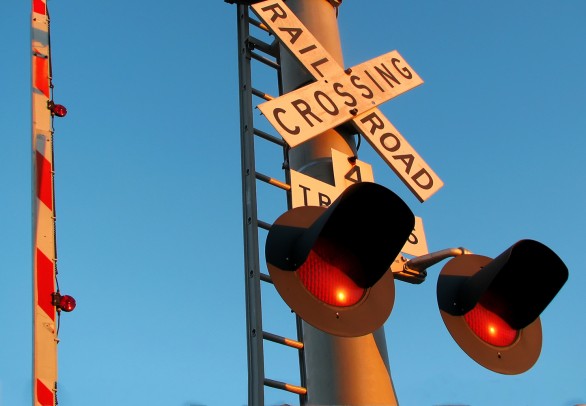Reducing risk at railroad crossings
 The risk of pedestrian and bicycle accidents at railroad grade crossings would decrease with sustained enforcement and education by local governments, along with consistency in design standards for warning devices, according to a study by the Urban Transportation Center.
The risk of pedestrian and bicycle accidents at railroad grade crossings would decrease with sustained enforcement and education by local governments, along with consistency in design standards for warning devices, according to a study by the Urban Transportation Center.
“Pedestrian and bicycle fatalities at highway-rail and pathway-rail crossings have remained constant over the past 10 years, in contrast to a marked decrease in vehicle collisions with trains,” said P.S. Sriraj, director of UIC’s Metropolitan Transportation Support Initiative.
Sriraj led the study with Paul Metaxatos, research assistant professor.
“Education and enforcement would convince pedestrians and cyclists that it is both dangerous and illegal to cross railroad tracks while signals are activated, or to cross anywhere but at designated crossings,” Metaxatos said.
The researchers’ review of signs and electronic warning devices nationwide showed “a distinct lack of consistency in standards to analyze/quantify pedestrian risk and design effective treatment.”
They found that signals at many crossings did not comply with professional standards.
Criteria for the choice of devices at each grade crossing include pedestrian volume, weather, train speeds, train volumes and surrounding land use. But few methodologies allow for assessing tradeoffs among those factors, the researchers wrote.
States like California, with substantial passenger, commuter and freight rail operations, are developing guidelines for safety improvements.
Compliant warning signs in use include pavement markings, audible tones, verbal messages, vibrating surfaces, fencing, gates, flashing lights and “second train coming” electronic warning signs.
The survey found that people paid the most attention to pedestrian gates, the most frequently suggested signal improvement.
The study found several other factors affecting crossing safety:
• Age: All ages noticed train-activated devices more often than passive signs, but older users more often noticed passive signs.
• Gender: Women survey respondents “appeared to be more safety-conscious than men,” the researchers wrote. Men under 21 were the only group that reported crossing against activated warning signals.
• Regular use: Pedestrians and cyclists who use grade crossings more often were less likely to cross illegally.
• Distractions: Talking on a cell phone, pushing a stroller or listening to music on headphones can limit awareness when approaching a crossing. Awareness also diminishes with age.
• Crossing in groups: Groups of pedestrians and cyclists, at train stations for example, often exhibit “platoon behavior,” with individuals following the crowd rather than checking for signals on their own. This can be especially dangerous when a second train is coming from the opposite direction, the researchers noted.
• Quiet zones: In communities where local authorities have established quiet zones, train horns are restricted or banned, making warnings less effective for distracted pedestrians.
• Funding for improvements: The “vast majority” of funding for rail crossing safety improvements is allocated to rail-highway crossings. Little funding is earmarked for pedestrian crossings.
The research team surveyed pedestrians at 10 “hot spots” in Chicago and collar counties; monitored the actions of non-motorized users through video surveillance; surveyed state regulatory agencies and industry professionals; and reviewed published studies on rail crossing safety.
The study report, “Pedestrian/Bicyclist Warning Devices and Signs at Highway-Rail and Pathway-Rail Grade Crossings,” was funded by the Illinois Center for Transportation and Canadian National Railway.
aranallo@uic.edu
